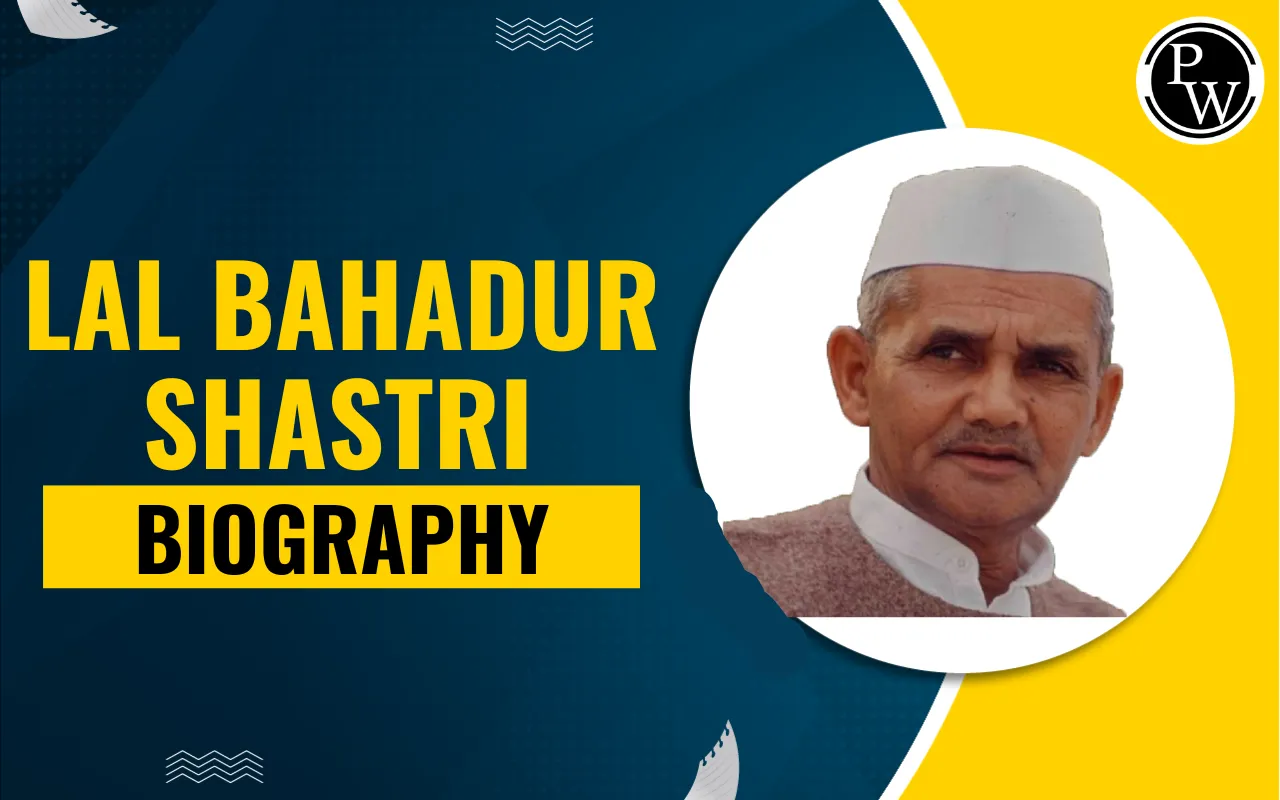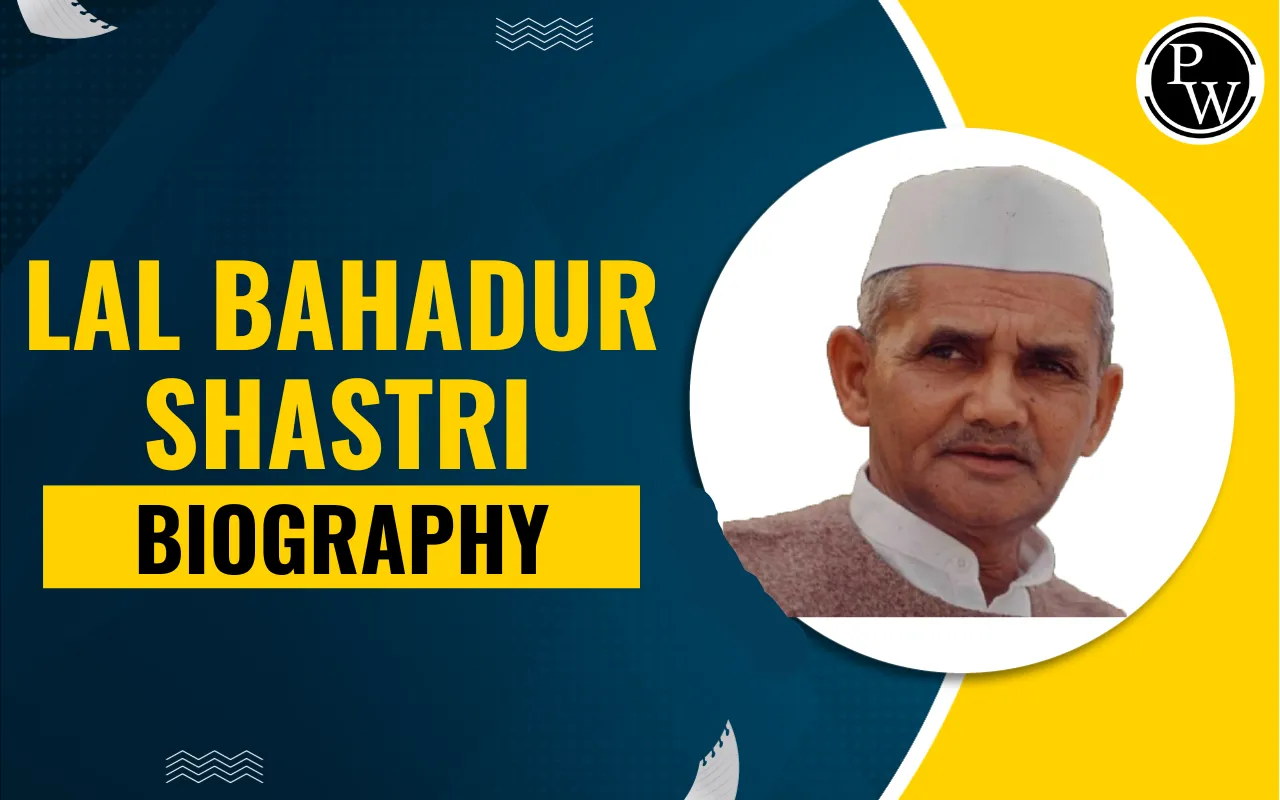

Lal Bahadur Shastri Biography: Lal Bahadur Shastri was an Indian politician who served as India's second prime minister. He played an important part in the country's campaign for independence from British colonial rule, as well as in moulding its post-independence fate.
Lal Bahadur Shastri Biography
Lal Bahadur Shastri was an Indian politician and statesman who served as India's second prime minister between 1964 to 1966. He previously served as India's sixth home minister, from 1961 to 1963. His simplicity, sincerity, and outstanding leadership during the Indo-Pak War of 1965 garnered him national esteem.
The leader noted for his slogan "Jai Jawan, Jai Kisan" emphasised the importance of both troops and farmers in nation-building and development. This biography, published on the occasion of Lal Bahadur Shashtri's birthday, will provide insight into his personal life, political career, accomplishments, and legacy. The day's strong devotion to peace, agriculture, and economic prosperity is still recognised and honoured in India.
Also read: Jawaharlal Nehru Biography
Lal Bahadur Shastri ka Jivan Parichay
Lal Bahadur Shastri rose from humble beginnings to become India’s respected second Prime Minister. This concise लाल बहादुर शास्त्री का जीवन परिचय covers his birth, education, and public service in one paragraph. He belonged to a modest family, embraced Gandhian simplicity, and entered public life through student and non-cooperation movements. Known for moral integrity, Shastri emphasized farmers and soldiers equally, coining the famous phrase “Jai Jawan, Jai Kisan.” His leadership in 1965 and his humane image made him widely beloved across India. This short bio answers high-volume queries like lal bahadur shastri and लाल बहादुर शास्त्री कौन थे.
Lal Bahadur Shastri Early Life and Education
Lal Bahadur Shastri was born on 2nd October 1904 in a small town called Mughalsarai in Uttar Pradesh. His father's name was Sharda Prasad Srivastava, who worked as a school teacher and later a clerk, and his mother’s name was Ramdulari Devi. When Shastri was just one year old, his father passed away, and the family faced a lot of financial difficulties. His mother took care of him and raised him with strong values like honesty, humility, and simplicity.
He was a bright and hardworking student since childhood. He studied at Harish Chandra High School in Varanasi. Later, he joined Kashi Hindu Vishwavidyalaya, a nationalist institution that promoted Indian values and education during British rule. There, he studied philosophy and social sciences and was given the title “Shastri,” meaning a scholar. His time at Kashi Hindu Vishwavidyalaya also shaped his thoughts about freedom, service, and sacrifice. This period laid the foundation for his simple lifestyle and dedication to the nation.
Shastri married Lalita Devi on May 16, 1928. The couple had four sons and two daughters, including Kusum Shastri, Hari Krishna Shastri, the oldest daughter, and Suman Shastri, the eldest son. Shastri, who stood 5 feet 2 inches tall, always wore a dhoti. He only wore pyjamas once, during a 1961 supper at Rashtrapati Bhavan in honour of the Queen of the United Kingdom.
Also read: Political parties in Uttar Pradesh
Involvement in Freedom Movement & Public Service
Lal Bahadur Shastri participated in India’s freedom struggle, joining movements like the Salt Satyagraha and Quit India Movements. He was jailed multiple times for his role in fighting against British rule. Here is the details of the movements:
-
Joining the Movement: Inspired by leaders like Mahatma Gandhi, Shastri actively participated in the Indian independence movement. In 1921, he joined the Non-Cooperation Movement and was briefly imprisoned.
-
Major Contributions:
-
Salt Satyagraha (1930): Led a door-to-door campaign in Allahabad, urging people to defy British salt laws.
-
Quit India Movement (1942): Imprisoned for his role in demanding immediate British withdrawal from India.
Also read: Freedom fighters of Uttar Pradesh
Lal Bahadur Shastri Political Career - Timeline & Key Offices
Lal Bahadur Shastri held key positions like Railway Minister and Home Minister before becoming India’s second Prime Minister in 1964. His political career was marked by honesty, strong leadership, and dedication to public service. Here is the details of his political career:
-
State Minister
Shastri was appointed Parliamentary Secretary in Uttar Pradesh, his home state. Rafi Ahmed Kidwai went to become a minister at the centre on August 15, 1947, and was appointed Minister of Police and Transport by Chief Minister Govind Ballabh Pant. He was the first to appoint female conductors during his tenure as Minister of Transportation. While serving as minister in charge of the Police Department, he instructed officers to use water jets rather than lathis to disperse disruptive crowds. During his tenure as police minister (or home minister, as it was known prior to 1950), communal unrest in 1947 were effectively contained, as were mass migration and refugee resettlement.
-
Cabinet Minister
Shastri was named general secretary of the All-India Congress Committee in 1951, while Jawaharlal Nehru was the president. He was critical to the Congress Party's landslide victories in the Indian General Elections of 1952, 1957, and 1962. In 1952, he successfully contested for UP Vidhansabha from the Soraon North/Phulpur West constituency, winning with more than 69% of the vote. Thought to be retaining his job as UP's home minister, Nehru unexpectedly summoned him to the Centre as a minister. On May 13, 1952, Shastri was named Minister of Railways and Transport in the Indian Republic's First Cabinet.
In 1959, he was Minister of Commerce and Industry; in 1961, he was Minister of Home Affairs. Shastri established Mangalore Port in 1964, while serving as a minister without a specified portfolio.
-
Prime Minister
Nehru died on May 27, 1964, while still in power. Shastri was appointed prime minister on June 9, 1964, by Congress Party president K. Kamaraj. Shastri was a Nehruvian socialist who was mild-mannered and soft-spoken, making him acceptable to those trying to prevent conservative right-winger Morarji Desai from gaining power.
Lal Bahadur Shastri Death, Tashkent Agreement & Legacy
-
Shastri died on 11 January 1966 in Tashkent (then USSR) soon after signing the Tashkent Agreement with Pakistan. His untimely death raised questions and remains a sensitive subject; the official cause was a heart attack. He was posthumously awarded the Bharat Ratna (1966) in recognition of his service. Institutions such as the Lal Bahadur Shastri National Academy of Administration and numerous roads and public buildings bear his name, preserving his legacy of honesty, humility and public service. This section addresses queries like “how was lal bahadur shastri honoured for his service to the nation.”
-
Posthumous Honors: Awarded the Bharat Ratna, India's highest civilian honor, in 1966. His legacy is commemorated through institutions like the Lal Bahadur Shastri National Academy of Administration and various roads and public spaces named in his honor.
Also read: Railways in Uttar Pradesh
Lal Bahadur Shastri Awards & Reognision
Shastri’s public life earned him national respect and formal honors after his death. Key recognitions include:
-
Bharat Ratna (1966) — highest civilian award (posthumous).
-
Multiple universities, colleges and public institutions named in his honor.
-
Annual commemorations on his birth and death anniversaries to mark his emphasis on farmers and soldiers.
Short Note for Students (Class 10/12)
Lal Bahadur Shastri (1904–1966) was India’s second Prime Minister who promoted Jai Jawan, Jai Kisan. Born in Mughalsarai, he studied at Kashi Vidyapeeth and entered the freedom struggle, later serving as Railways and Home Minister before becoming PM in 1964. He died in Tashkent in 1966 and was awarded the Bharat Ratna. This 4-line note is suitable for quick school answers and exam revision.
Personal Life & Family (Concise)
Shastri was born to Sharada Prasad Srivastava (father) and Ramdulari Devi (mother) and hailed from a modest Brahmin family in Uttar Pradesh. He married Lalita Devi in 1928 and the couple had six children (four sons and two daughters). Family details frequently appear in GSC queries like father of lal bahadur shastri and Lal Bahadur Shastri daughter name, so this section lists parents and children in one short paragraph for quick reference.
